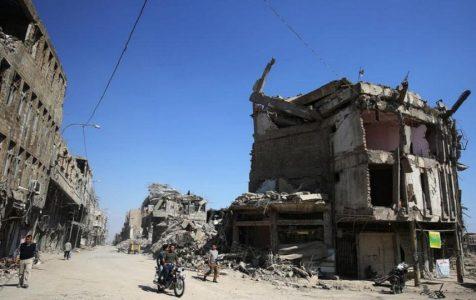
ISIS sleeper cells are plotting terrorist attacks in northern Iraq
ISIS has carried out a series of deadly attacks in northern Iraq that are being attributed to the group’s use of sleeper cells in an offensive that could disrupt the country’s upcoming elections.
The violence – at least 25 civilians and government fighters have been killed since Sunday – has been centred around Kirkuk province, with the insurgents boldly established checkpoints on the main road to Baghdad.
The uptick in attacks indicate that despite no longer controlling large swathes of territory, ISIL is far from a spent force in Iraq, undermining the government’s claim that the group has been defeated.
In December, Prime Minister Haider Al Abadi declared final victory over ISIL, after national security forces recaptured the last main areas controlled by the group.
But previously dormant fighters now appear to be mounting a campaign to undermine the nation’s parliamentary elections in May.
“There are terrorist activities ongoing around Kirkuk, and on the Baghdad road,” a senior police officer told The National, recounting suicide car bombs, raids, the assassinations of people close to the government or security forces, and fake checkpoints. The officer asked not to be identified due to the sensitivity of publicly acknowledging that ISIL is regrouping.
The government has largely retained control of the country this year but other liberated areas such as Salahaddin and Diyala provinces have already suffered ISIL attacks.
Mr Abadi has acknowledged the threat posed by ISIL but any sustained effort to kill civilians, soldiers or police would undermine the prime minister’s push to voters that he is the best candidate to protect Iraq from attack.
On Sunday evening, ISIL members set up a temporary checkpoint on the highway between Kirkuk and the Iraqi capital. The militants then reportedly attacked a car travelling south between Daquq and Tuz Khurmato — an ethnically mixed area previously riven by sectarian tensions. Five members of one family were said to have been killed. ISIL claimed responsibility for the attacks and published footage from the ambush which it said targeted Shiites.
The unrest also threatens to destabilise oil-producing Kirkuk province, parts of which changed hands last year when national police and soldiers took over from Kurdish forces who had held the eponymous city and its oil fields since 2014.
In a document released on March 8, ISIL claimed to have carried out 58 attacks around Kirkuk since December 20. Entitled “Harvest of Kirkuk”, it listed a string of assassinations, suicide attacks, raids and improvised explosions that the group said had killed or injured 153 members of the Iraqi security forces.
Security sources told The National that ISIL sleeper cells have been able to take refuge in large tracts of ungoverned areas around the town of Hawija and in the Hamrin Mountains, emerging to carry out hit and run attacks.
In one such attack in mid-February, 27 Popular Mobilisation Forces (PMF) Shiite militiamen were reported killed in an ISIL ambush in Hawija. Reasserting government control over such a large rural area has proved to be beyond the capabilities of Iraqi forces, which remain stretched after three years of concerted fighting against insurgents.
“The militants are regrouping and retraining to carry out attacks on security forces in the region,” Sarhad Qader, the former police chief of Kirkuk, told The National.
“There are hundreds of villages around the Hamrin mountain range which are beyond security forces patrols and control.”
Mr Qader, a Kurd who was ousted from his role last October after federal forces reasserted control over Kirkuk, said: “The road of Baghdad from Kirkuk traverses remote areas. That makes it easy for ISIL militants to carry out ambushes.”
The ability of ISIL members to blend into communities has also made them hard to pinpoint and dislodge.
“The ISIL militants are local and they know the area very well that give them advantage over the security forces,” Mr Qader added. “They can move relatively freely in the area and the villagers cannot object because if they cooperate with the security forces they know how severe the consequences will be for them.”
ISIL also appears to be regrouping in Nineveh province, whose capital Mosul is still severely damaged from a nine-month battle to recapture it which ended last July.
Police last week released photos of what it said was a huge weapons cache being transported to the northern city’s Al Quds neighbourhood. The photos showed crates of ammunition and hundreds of rocket propelled grenades and assault rifles, many still wrapped in plastic from the factory.
With billions of dollars of damage inflicted on areas hit by fighting against ISIL, Sunni leaders in Nineveh are trying to maintain close relations with the Baghdad government to secure investment for reconstruction.
While it appears unlikely ISIL could recapture or hold large tracts of territory like it did in 2014, when around a third of the country came under their control, the potential for escalation remains.
“I don’t know whether we could call this a proper insurgency as of now, but there are signs that it could develop if action is not taken,” said Sajad Jiyad, the managing director of Al-Bayan Centre for Planning and Studies, a Baghdad-based think tank.
“The area around Kirkuk and Hawija has not been liberated for long, and it takes time to reassert control and for intelligence and local security forces to get to grip with what’s going on in these villages and towns. Our forces are fully stretched trying to secure the Syrian border, the Baghdad belt and other areas.”
With Turkmen, Kurds, Sunni and Shiite Arabs living in disputed territories, the region has long been fraught with sectarian tensions. “The dispute between the Kurdistan regional government and Baghdad over territory is something that Daesh is looking to take advantage of,” Jiyad added, using the Arabic acronym for ISIL.
Source: The National





